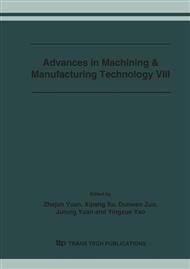p.154
p.159
p.164
p.169
p.174
p.180
p.185
p.190
p.195
The Application of FEM Technology on the Deformation Analysis of the Aero Thin-Walled Frame Shape Workpiece
Abstract:
Many thin-walled structure components widely used in aero industries not only have complex structure and large size, but also need high machining accuracy. However, because of their poor rigidity, it is easy to bring machining deformation caused by the existence of the initial residual stresses, the fixing stresses, cutting forces and cutting heat. The difficulty in ensuring their machining accuracy becomes a big problem, so that how to effectively predict and control the machining deformation has become an important subject in the development and production of our national defense weapons. This paper established a 3-D Finite element model with consideration of milling forces, clamping forces and initial residual stress field. By using this model, machining deformation of thin-walled frame shape workpieces has been computed. The simulated results are compared with experimental data, and the correctness of the simulation is verified. The study is helpful to the prediction and the control of machining deformation for thin-walled parts.
Info:
Periodical:
Pages:
174-179
Citation:
Online since:
July 2006
Price:
Сopyright:
© 2006 Trans Tech Publications Ltd. All Rights Reserved
Share:
Citation:


